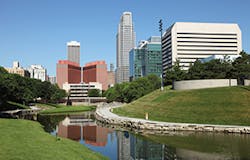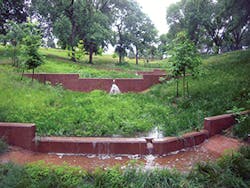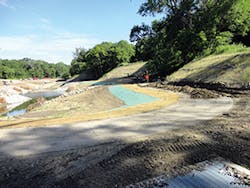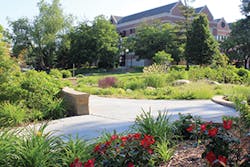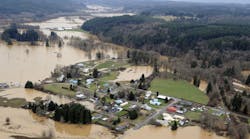As Kermit the Frog is known for singing, sometimes it’s not easy being green. And sometimes it isn’t easy being—or implementing—green or gray infrastructure, at least when it comes to managing stormwater on a budget and under challenging conditions, such as those found in Omaha, NE.
“We’re seeing wetter years than before, and our geography is challenging. We have highly erodible soils with low infiltration rates. We have cold winters and very hot summers—extreme conditions for plants,” says Nina Cudahy, environmental quality control manager for the city of Omaha.
Like many cities, Omaha is working to correct overflows from its aging combined sewer system (CSS). A ridgeline runs through the middle of the city. The older, eastern section of Omaha has a CSS, while the newer west side has entirely separate storm and sanitary sewers.
“Our CSO [combined sewer overflow] program is under consent decree from the state, but not from federal,” says Cudahy.
Eliminating CSOs by separating the systems is part of a long-term plan that was developed in 2009. The city began implementing CSO projects in the plan in 2011 and will finish in 2027.
Omaha does not have a stormwater utility. “We have an administrative fee similar to that in the sewer regulations, but it can be used only for administrative-related expenses, such as supporting inspections, not for maintenance and operations,” explains Cudahy.
She adds, “Omaha and Lincoln teamed together to have the state legislature pass a stormwater utility, but after 12 years of trying, we gave up.”
Omaha began to use green infrastructure more often for stormwater management after the city’s stormwater ordinance was revised in 2008. Now all new construction projects have to treat the first half-inch of runoff onsite.
“We’re seeing a lot of private projects going in with green infrastructure,” notes Cudahy.
Elmwood diversion weirs with flowing water
Omaha’s Public Works Department has had great success with using green infrastructure to manage stormwater in projects that are developed with the city’s Parks Department. Cudahy says these larger park projects have drawn good response from the public.
John Royster, FASLA, is CEO of the landscape architecture firm Big Muddy Workshop in Omaha. (The firm’s name comes from what Nebraskans call their river—the Missouri, not the Mississippi—and Royster’s belief that “workshop” best connotes his approach to landscape architecture, i.e., a craftsman’s approach.)
Royster says, “It’s fun to see the good participation between Public Works and the Parks Department. How we use stormwater to improve our parks saves the taxpayers money and enhances our parks.”
Spring Lake Park
The stormwater project at Spring Lake Park is a good example. It is located on the south side of Omaha. “South Omaha is a unique community,” says Cudahy. “There is a lot of industry there, and it has an ethnically diverse population.”
Some years ago, an actual Spring Lake existed. Nobody knows exactly why or when, but the lake was drained.
Royster thinks that with the city’s highly erosive silt soil, “as Omaha developed, a lot of soil went into the lake. The combined sewer system in that part of town was the death of the lake. The sewer line that served a 400-acre watershed went through the center of the lake bed.”
The park project reintroduced the small lake (about 1.5 acres) and added a treatment train and wetlands. The CSS was separated. “There were remnants of the wetland and a small stream, so there was a good baseflow [to build on],” says Royster. “A sand seam runs under a big portion of Omaha. It slopes to the east and into the bottom of this valley.”
Spring Lake under construction
The lake also provides a flood control benefit, as stormwater is temporarily detained coming through the treatment train. “In the first 24 hours after a large storm, the water rises as much as three feet, and then it is slowly released into the lake,” says Royster. “Spring Lake itself is a small part of the treatment train, which starts at the edge of the park where stormwater enters a storm inlet. There, SAFL Baffles [made by Upstream Technologies of New Brighton, MN] trap trash and debris.”
“Then, the water goes through a series of 13 water-quality basins around the perimeter of the park. Trash and sediment drop out,” he continues. “The water goes through bioswales and flows into a constructed wetland. The wetland has two areas, one with submerged gravel.”
Area residents will gain much-needed recreation from the walking/running path that surrounds the lake, and from fishing. The improved habitat will draw birds and other wildlife.
“The water in the lake has to be 12 to 16 feet deep so the fish don’t freeze over the winter,” says Royster. “The CSO program couldn’t pay for that recreational benefit, so the city applied for, and received, a grant from the Nebraska Environmental Trust, a state agency that receives proceeds from the state lottery.”
The major construction at Spring Lake should be finished this year. The project’s second phase—tree mitigation—will be done next year.
“The area was heavily wooded. We had to clear up the ravines, so we’ll go back and plant trees to replace those that were removed,” says Cudahy.
Royster says that the trees will be “all native trees—basswood, bur oak, elm, hackberry. All of the seeds for the mitigating trees were locally collected.”
Whenever possible, he prefers to use bag-grown trees. The 7-gallon bags are made of geotextile fabric. When planted, the trees have grown to be 5 to 7 feet tall. Their trunks measure one half to three quarters of an inch in diameter, sometimes 1 inch.
“They develop such a dense root system. They’re much more adaptive than ball-and-burlap trees. These trees withstand drought well,” he says.
Using green infrastructure in the Spring Lake CSO project paid off big time. The cost was $5 million compared to the original estimate of $11 million for gray infrastructure.
Originally, Royster says, “we thought we would use the current combined pipes for the sanitary sewer system and install new stormwater system pipes. Because of all the stormwater treatment in the park, we are actually using the existing pipes for stormwater and building new pipes for the sanitary sewer system.”
The sanitary sewer system will be adequately served with new pipes that are much smaller, hence, much cheaper. The park’s well-functioning green infrastructure treatment train “offset a lot of gray infrastructure cost.”
Through a lot of teamwork and insightful design, “we created a wonderful amenity, a recreational benefit, and an environmental benefit—and saved a slew of money,” notes Royster.
The sidewalk that runs around the entire perimeter of the lake measures 10 feet wide. It was designed to allow city employees convenient close access for removal of sediment. A bonus, Royster says, is that the sidewalk qualifies for “‘universal acceptance.’ Everyone, even people in wheelchairs, can use it.”
Elmwood Park
Another major CSO project in which green infrastructure plays an essential part is the stormwater diversion at Elmwood Park. This 2012 project won a Merit Award from the Great Plains Chapter of the American Society of Landscape Architecture.
Big Muddy Workshop was the landscape architecture sub-consultant to engineering firm Veenstra & Kimm of West Des Moines, IA. The engineering firm provided civil and water resources engineering and project management.
The stormwater diversion includes concrete weirs, bioretention gardens, areas of native grasses, and detention ponds to slow and treat stormwater in the 29-acre park. Elmwood Park lies within the 169-acre Aksarben Village watershed where the CSS was separated.
The top portion of the watershed was fairly flat, but about half of the water drained down a very steep hill. The bottom of the hill was flat, but it was only about 1/4 mile from the receiving body of water, Elmwood Creek.
“Because of that great change in elevation and topography, we needed an incredible amount of storage at the bottom,” explains Royster.
The solution was complicated, because stormwater would back up in the pipes during a heavy storm. “We didn’t have enough room to put larger pipes under the street.”
The land is located where two watersheds met. “We were collecting that water from the Aksarben Village watershed and putting it in the Elmwood Park Creek watershed, which was only a block away,” says Royster.
Elmwood Park has three bioretention gardens where stormwater infiltrates. Originally, the gardens were planted with a palette of 13 or 14 species. “After three years, we looked at the plants. The Joe Pye weed was doing very well, but we had lost a lot of grasses and wildflower forbs,” explains Royster.
Plants from fewer species were used to replace those that had died. This is a trend that Royster sees on other projects.
“We are continually going to simpler plant palettes. The beds are not as colorful, but they’re probably lower maintenance, and more plants thrive,” he says. “We’ve been doing green infrastructure since 2008. When we started, we took a very horticultural approach, arranging plants carefully for height, texture, color. We always lost a large percentage of some species. Now we use a lot fewer species. Our mantra on plants for green infrastructure projects is ‘simpler, cheaper, better.'”
Plants that are doing well at Elmwood Park include prairie spiderwort and sneezewort. Native grasses include several varieties of sedges—plains oval, palm, Pennsylvania, and fox—plus Northwind switchgrass.
Royster terms as the project’s main challenge “the amount of grade drop in a short distance. We wanted to maintain the natural streambed. We didn’t want to armor the stream. We have silty, highly erodible soils that we have to protect from erosion.”
The solution was to install a series of weirs and two-stage weirs cascading down the ravine and matched to its geometry. When water first goes over the weir it hits a concrete apron.
Flexamat was installed below the concrete apron. This permanent erosion control product is made of concrete blocks locked together within a geogrid. It holds the soil in place and allows plants to grow through it. Royster describes the Flexamat (made by Motz Enterprises) as “a slick product.”
To handle a 100-year storm, the concrete weirs would have had to have wing walls 4 or 5 feet high. This much hardscape would have been intrusive and unattractive. Instead, an underground diversion pipe was installed.
The Elmwood Park stormwater diversion is another CSO project that saved money by using green infrastructure instead of gray—larger pipes. The savings totaled $600,000.
What was a forgotten ravine is now a park amenity where people walk and children play. Wildlife habitat has attracted birds and other animals.
Cole Creek
Big Muddy Workshop also worked on the restoration of Cole Creek in 2010. This stream flows through Orchard Park.
“Orchard Park is one of those first [green] projects that found success in Omaha. It’s been a bit of a catalyst to take every project another step further,” says Katie Pekarek, extension educator for water quality at the University of Nebraska at Lincoln.
The green infrastructure at this location is “bioretention to treat water coming off of the street,” says Cudahy. “We have a pretty extensive monitoring system there to measure how the water behaves.”
“As the stream’s banks eroded, heavy storms brought flooding. There was no floodplain for the water to tame down,” says Royster.
He says the two big bioretention areas are almost 300 feet long by 12 feet wide, located between the creek and some tennis courts. The creek was realigned to direct water away from the tennis courts. Any runoff that doesn’t infiltrate flows into the creek.
“We had to take out a number of trees along the creek,” says Royster. For mitigation, “we used bioengineering, which was significantly cheaper. During the winter, native plant material was collected, including willow, dogwood, and cottonwood.”
These shoots of shrubs and small trees measured 1.5 to 2 inches in diameter. The trees were 6 to 8 feet tall. “We used a Waterjet Stinger to push them into the soil,” he adds.
These live stakes, kept in moist soil, grew roots. Shrubs were planted in masses to slow water down, which also created a diverse wildlife habitat with hardy native plants.
A loop walking trail with two crossings over Cole Creek encircles Orchard Park. Part of the land was planted as a restored prairie with native grasses. The trail tilts toward the prairie so water flows into this area.
Urban Projects
Successful green infrastructure stormwater projects in Omaha aren’t limited to its parks. Using green infrastructure in urban locations anywhere presents its own challenges, but Omaha has done that as well. One such stormwater project is along Florence Street.
This urban street in the historic district of north Omaha has seven bioretention gardens within the sidewalk. They are situated close to the street along two blocks of the business district.
The project was designed by Vireo, a Kansas City, MO, landscape architecture firm. Swan Construction Company and Yano’s Landscaping did the construction.
Florence Street’s bioretention gardens capture and treat the first half-inch of runoff from the surrounding street and sidewalk. The drainage area is about 1.8 acres.
The project was finished in September 2012. Photos taken about two years later show lush plants that look as though they have been growing there for many years. The plants include several types of sedges and red twig dogwood.
Because of Omaha’s silty soils, a typical streetside bioretention garden wouldn’t function as well as required. A pretreatment feature—a sump—that looks like a window well was added to each bioretention garden.
“We fabricated the metal walls here and put notches in them, to keep expenses down,” notes Cudahy. The bases of the walls sit on slabs of pervious concrete. Cudahy says it’s very easy for maintenance crews to scoop out the sediment that the runoff has deposited there.
Water flows beyond the pretreatment sump into a perforated pipe that is connected to the underdrain. The drain is made of 4-inch perforated dual-wall HDPE pipe.
Another change is the composition of the infiltration media. Most cities remove the existing soil and replace it with engineered soil. But Omaha has inconsistent rain patterns; summers are hot and plants have to be drought tolerant to survive.
“That gravel storage underneath isn’t effective for our plants, so we leave the existing soil there. We’re relying on the plants to do the work, to extend their roots to fracture the compacted soil,” says Cudahy.
She adds, “Usually you say three years is needed for plants to become established, but we’re seeing that it takes one or two years for them to be established. The plants have really taken off.”
Another interesting stormwater project with a strong green infrastructure component is located at the entrance to the Visitors Center on the University of Nebraska at Omaha campus. Two bioretention areas sit in a complementary yin-and-yang design.
The garden area, including the plants surrounding the bioretention cells, is about 4,500 square feet. The garden infiltrates runoff from approximately 24,000 square feet, including the roofs, paving, and turfgrass areas.
Big Muddy Workshop created the design for the 2012 project. The plant palette was selected by UNO’s director of sustainability, Steven Rodie, FASLA, who is also a faculty member in the Biology Department.
Rodie used both native and adaptive plants, aiming to include some plants that aren’t usually included in bioretention areas. “I’m letting the plants show me where they’re willing to grow,” he says.
For example, the Missouri primrose, with yellow flowers, is very drought tolerant. Rodie didn’t plant it in the stormwater section, but it is growing there anyway in the bottom, where conditions are wettest. Rodie thinks the wind blew some of the plant’s large seed pods there.
Low walls encourage students and campus visitors to sit and enjoy the beauty of the site. Students in various classes use the bioretention areas for research or classwork.
Plants include button bush, milkweed, black chokeberry, asters, Joe Pye weed, goldenrod, and sedges—”one of our best bets, six or eight different kinds,” says Rodie.
“I design for fall. It’s a beautiful time of year here, and the students are back in school. Native plants attract native pollinators. It’s amazing to see so many butterflies clinging to the asters that are flowering even in November,” he says.
Plants growing around the edge, such as blue grama and little bluestem, are not part of the stormwater capture. Rodie thinks plants along the borders of bioretention areas can help the general public appreciate them instead of expecting them to look like regular gardens.
“If you create good edging, maintain plants, and don’t choose tall plants that flop over—how they’re placed matters—people will accept them, even [sections of] grasses,” he says. “I’m using more grasses, sedges, rushes in masses,” he adds. “This type of rain garden doesn’t depend on flowers for people to say it looks nice.”
Saddlebrook has an elementary school, a public library branch, and a community center on the same green campus. A joint project by the city of Omaha, the Omaha Public Schools, and the Omaha Public Library, Saddlebrook’s buildings and landscape design were done by BCDM Architects.
Saddlebrook includes a bioretention area between two parking lots, dry detention basins, plantings of native prairie grass, and a green roof that is adjacent to a traditional roof. Extensive monitoring takes place comparing the two roof sections.
The proximity of the library and the school offer many opportunities for public outreach and environmental education activities for the children and older residents. Educational signage attracts the attention of children playing and recreational walkers.
“We like to partner with schools for demonstration projects,” says Cudahy. She cites examples of the large bioretention garden that takes runoff from the parking lot at Creighton Prep and the bioretention garden at Dundee Elementary, which replaced a grassy area worn bare and corrected drainage issues.
Rodie enjoys projects and events that involve UNO students teaching and working with local high school or elementary school students. One of his favorite projects, at Benson West Elementary School, is a bioretention garden that includes a memorial to a child who was a student there.
His design at Omaha Northwest High School was inspired by a student who asked if he had ever created a bioretention garden shaped like a butterfly. The garden there will infiltrate water through the butterfly’s “wings.”
Rodie says green infrastructure “is doing very well in Omaha. We have people in Public Works and in city government who are willing to experiment, to try new things.”
Royster notes, “The total cost of the CSO program in Omaha continues to rise. It’s about $1.7 billion to cover our CSO program. It’s so incredibly expensive that everybody has to be open [to using green infrastructure].”
He adds, “The city Public Works Department has a forward-looking staff. They say, ‘Other cities are doing green infrastructure. Why not try it here?'”
Reflecting on the challenges of managing stormwater in an area with extremes of weather and silty soil with low infiltration, Royster says of green infrastructure, “If it works in Omaha, it can work anywhere.”
